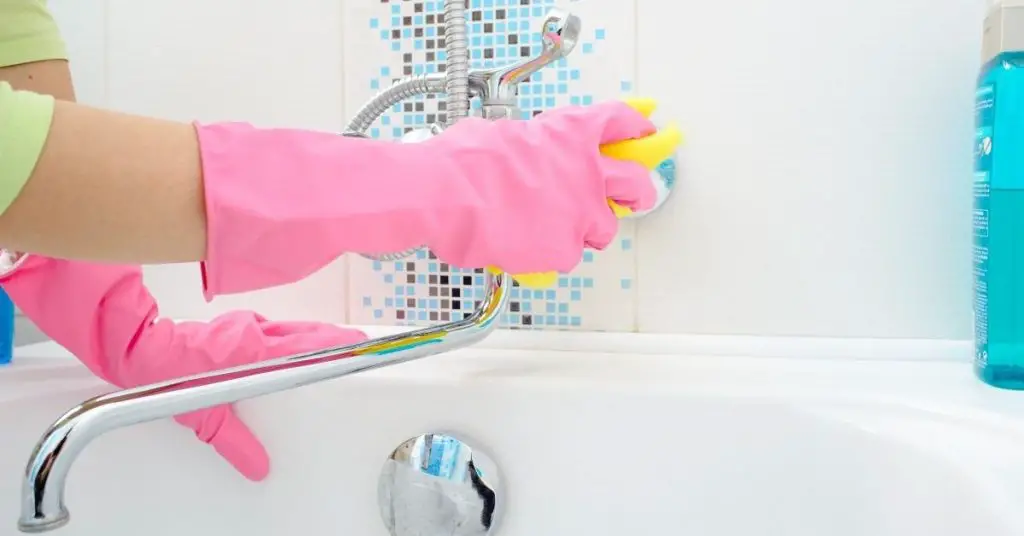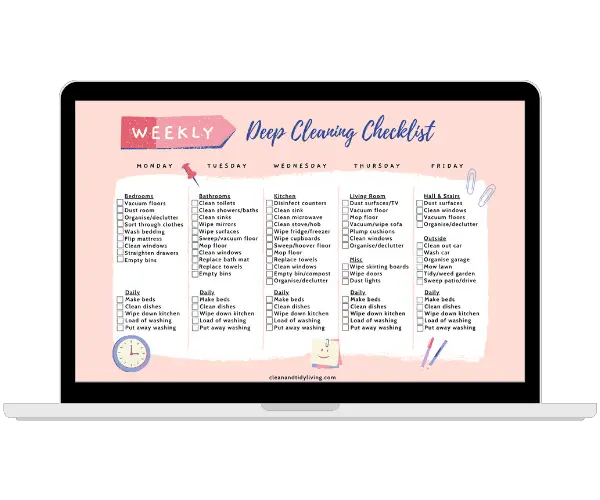Do you need a Cleaning Schedule?
How do you decide what and when to clean? We all have similar habits and routines but it’s unlikely anyone is exactly the same. Having a cleaning schedule streamlines this process.
Some people just clean up as and when it’s needed, and others know in the back of their mind when it’s time for a tidy-up.
This works great for some, but as lives and houses get busier, it becomes increasingly difficult to stay on top of daily chores.
Piles of laundry start to build up, and tasks get neglected due to there just not being enough hours in the day.
One system that works great for keeping on track with home-cleaning is monitoring progress and ensuring jobs are complete with a schedule.
In this article, we will explain what a cleaning schedule is, how they can help and how you can make your own.
What is a Cleaning Schedule?
A cleaning schedule is a checklist of tasks that need to be completed to maintain a clean and tidy home.
This might be broken down into daily, weekly or monthly checklists depending on the goal of the checklist.
Other features might include dividing the tasks between members of a household, and a reward system for children when their jobs are done. This could be gold stars, movie nights, or pocket money.
What are the benefits of using a chore checklist?
Progress is Motivational
The power of the checkbox! That feeling of satisfaction you get when you tick off a job on your to-do list is a fantastic motivator.
Being able to see your progress, and knowing how close you are to completion will spur you on to get those pesky chores finished.
A tidier and cleaner home
Of course, the most important benefit from a cleaning schedule is having a cleaner home!
Not only will it look cleaner and tidier, but you’ll have the inner knowledge that it actually is and that nothing has been missed off your list.

Better mental wellbeing
The combination of an organised home and a stress-free mind (well, free from cleaning stress at least) can do wonders for productivity and quality of life.
Writing down all of your home tasks takes them out of your mind and down on to paper, giving you a feeling of control and a sense of relief.
No more lying in bed thinking “I need to dust the skirting boards! Oh, I forgot to wash the couch cushions. I’ll have to tidy under the sink tomorrow…”
Encourage responsibility in kids
Allowing kids to see their daily and weekly chores on a visual and colourful chart can be a great way for them to learn responsibility.
They’re able to experience the same satisfaction we do when a job is done and they can earn stickers as rewards for an extra spur of motivation.
Fewer Cleaning Tasks & Chores are forgotten
Dissecting each room into every single task that could ever need doing ensures nothing will be forgotten.
You’ll have peace of mind that everything has been done, and can keep your home looking its best.
How to Create a Cleaning Schedule
Here’s a nice video explaining how you can make your own cleaning schedule. We’ve explained our process below in 8 steps.
- Make a list of every room in your home, and break down that room into each tiny task that needs doing.
For example, the bathroom might look something like this:
- Clean shower
- Wash toothbrush holder
- Dust radiator
- Dust shelves and sufaces
- Clean sink
- Clean toilet
- Polish mirror
- Vacuum floor
- Mop floor
- Wipe windows
- Dust skirting boards
- Empty bin
- Wash towels and bath mat
- Sort and group your task list by frequency. Which jobs need doing daily, weekly, monthly or every few months?
- Decide how you want your chore list sorted, do you clean one room a day or do you do all of the vacuuming on one day and dusting the next?
- Choose a platform to make your schedule. This could be by hand, in Excel, Google Sheets, or get creative with Canva!
- Make headings for each day or room and put your chores into their relevant groups. You can make sections for daily tasks, weekly tasks and monthly tasks.
- Include names and a rewards table if the schedule is for kids.
- Include check boxes so you can mark off when a task has been done.
- Make it pretty! Include graphics and colours so you’re excited to use your new cleaning schedule, and display it somewhere you can see. We think the fridge is the perfect place.
| Top Tip: Laminate your printable cleaning schedule and use whiteboard markers so you can wipe off the ticks and start again each week! Use a different colour for each person so you can see who’s done which chore. |
Different types of cleaning task lists
Download or make a printable checklist
There are lots of cleaning printables online you can download for free, but they might not exactly match your home and possessions.
By making your own you can tailor it to your lifestyle, family and cleaning routine.
Our FREE deep cleaning checklist is a great example of how to clean every day and keep on top of housework. Just click on either button below to download and get started.

Use an excel spreadsheet As your Checklist
Some people don’t get on with Excel and Google sheets but for others, it’s the best part of their day.
The great thing about using a spreadsheet to keep track of your cleaning is that each time you’ve completed it, you can just delete your entries and start fresh next week or month.
If you’re a serious Excel fan, you can even add features like percentage complete, predicted completion time vs. actual completion time, average time per day etc.
Add repeating Chores and Tasks to your calendar
A simple way to schedule chores is to add each task to your calendar on a daily, weekly, or monthly repetition. You’ll never forget a task and can move tasks around to match your schedule.
We like using Google calendar so we can see our schedule on our phones and computers. The smallest block you can use on Google calendar is 15 minutes, which is perfect for most chores.
Cleaning Schedule FAQs
What is a good cleaning schedule?
If you’re wanting to make a truly effective cleaning schedule, follow the steps to create ‘SMART’ objectives. You might have heard of these in the workplace, but they can also apply brilliantly to our home lives. A SMART objective is Specific, Measureable, Achievable, Realistic (or Relevant), and Time-Bound. Make a list of these objectives and sort them into each room, day of the week, or a list of weekly objectives. You’ll then have a great starting place for a cleaning schedule that organizes your thoughts and makes a huge difference in your home.
Where do I start cleaning a messy house?
When tackling a big job like a messy or dirty home, we like to start with the largest surface area first. Instead of cleaning the dirtiest thing, like a moldy shower or greasy stove, tackle the floors first – or if they’re tidy then start with all visible flat surfaces. With this method, you can immediately see the progress, and get that feeling of achievement straight away. Starting with a small but difficult job uses up all your energy quickly, but doesn’t show a huge amount of progress.
Summary of a Cleaning Checklist
The great thing about cleaning schedules is they can be tailored to your lifestyle and routine.
If you liked this post and want to download our Clean and Tidy Living cleaning schedule, use the buttons above to get free access.
We hope this article has explained what a cleaning schedule is, the value it brings and how you can make one yourself.
Related Cleaning Articles:
- My House Is Messy, Where Do I Start?
- How To Get Motivated To Clean And Declutter – 17 Tips
- Speed-Cleaning Tips: How To Clean Your House In 2 Hours
- How To Tidy Your Room Quickly & Efficiently
- What To Do When You Can’t Keep On Top Of Housework
- Can A Messy House Cause Anxiety?
- How To Quickly Declutter Your Home & Keep It Clutter-Free
- How To Keep Your House Clean And Tidy: 13 Helpful Tips
- The Best Storage & Organisation Essentials You Need At Home
- What Causes Someone To Not Clean Their House?
- How Do I Start Spring Cleaning My House?


THANK YOU SO MUCH!
We’re so pleased you’ve found this article helpful!